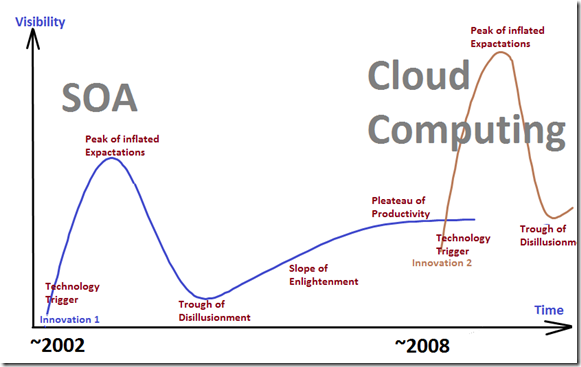SOA is dead; Long live…… well, Services ;-)
In her excellent blog post today, Anne Thomas Manes from the Burton Group declares the “official” passing away of the term SOA on January 1st, 2009.
Once praised as the solution to all IT problems, SOA did not result in measurable benefits for most, but a few, companies. I really recommend reading the article that discusses the failures and opportunities the recently deceased SOA paradigm left behind.
It is not a secret, I am NOT a fan of buzz words. I believe that buzzwords in the Software Industry are too often misused, misunderstood, and rarely keep their promise, especially if they are propagated as solutions to all the worlds problems. Nevertheless, I believe that paradigm shifts are necessary to improve on the status-quo (and in the IT field there is still lots of room for improvement ;-)). These paradigm shifts are based on the innovation curve. That means a new paradigm, if it catches on, gets first over hyped, then we get over pessimistic before we find the productivity plateau for the paradigm, which in turn triggers the adoption of new paradigms that improves on the experiences of the previous paradigms.
In the graph below I tried to capture this. The SOA hype started around 2002 and actually held up for a long time until the term Cloud Computing took over the headlines of the IT magazines.
I think this reflects very much what we see today. Cloud Computing as new paradigm includes many other current notions we use such as SaaS and Web 2.0. The interesting point to make is that we are still in the very early stages of defining the notion of cloud computing. If we ask 10 people in the industry for a definition of the term cloud computing today, then I am sure it would result in 12 different explanations. This is very similar to what we saw with the term SOA in the early stages. Let’s hope that we are not falling into the trap of equalizing the architectural paradigm with certain technology implementations (as we did too often with SOA and web services).
From the Microsoft perspective, the notion of S+S fits very nicely into the new paradigm of Cloud Computing as a natural evolution form SaaS and SOA. The S+S vision reflects the reality that we will have very diverse requirements for software systems. These requirements include the “old fashioned” but very powerful client applications, rich web applications, as well as reusable services hosted either in the cloud or on premise. Exciting times are ahead, despite (or because of) the death of SOA ;-)……
